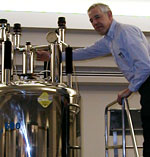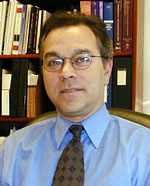| Underneath the glory that comes with major research breakthroughs at the University of Minnesota is an enormous economic system. There are huge costs associated with supporting university research, including buildings, equipment, and faculty, and there are potential payoffs as well via the use of patents and patent licenses.
 |
U of M researcher Robert Vince developed a series of compounds which led to the new AIDS drug, Ziagen. Over the next decade, the university could collect up to $300 million in royalties from the drug company which sells Ziagen, Glaxo Wellcome.
The Top 10 research developments at the U.
(Photo courtesy of University of Minnesota)
|
"THE COST OF OUR PROJECT SO FAR is about $250,000 and that's really cheap," says Dr. Pam Skinner matter-of-factly.
Skinner is a University of Minnesota researcher in Microbiology. She and her colleagues are producing microarrays - glass slides filled with thousands of mouse genes for work on genetic connections to diseases. She says the estimate for running the laboratory where she works is about $1 million per year.
In a nearby building, Senior Research Associate David Live runs the Nuclear Magnetic Resonance Laboratory, where researchers study the structure of, and relationship among, biological molecules. Its applications include the development of drug therapy and understanding disease processes.
"NMR is probably one of the most valuable techniques overall in chemistry and biochemistry," Live says. "One of the more expensive ones. The realistic cost of constructing a lab like this and equipping it is in excess of $5 million."
These are just two examples of the cost of research which is being conducted all across the U of M campus. And those costs have skyrocketed over the past 30 to 40 years.
"When I was a young professor just come to the University of Minnesota, we might have received $10,000 or $20,000 to set up our lab and get started," says Victor Bloomfield, Vice Provost for Research. "Now, when I try to attract a young faculty member in biochemistry or related discipline to the University of Minnesota, we typically have to provide them with $350,000 or $400,000 worth of set-up equipment, supplies, and personnel support for the first couple of years."
University of Minnesota researchers are engaged in some 4,000 research projects. Those faculty and researchers have become quite good at securing money to pay for what they do. In fiscal year 2000, they secured a record $455 million in research grants, the vast majority of that from the federal government.
In a January 7, 2001 presentation to the House Higher Education Finance Committee, University of Minnesota President Mark Yudof emphasized the economic benefits of university research to the state.
"Each faculty member at the university, on average, brings in
1.5 times his or her annual salary by way of research grants from other funding agencies," Yudof said. "Those research dollars employ many Minnesotans; the money remains in Minnesota, and as often as we can arrange it, the technology transfer is to Minnesota companies."
University officials credit faculty members for their aggressive pursuit of research grant money, and point out that achieving grants is a highly competitive endeavor in which faculty are competing with peers from across the country.
"The research mission is largely supported, except for the salary piece, by outside funds," according to College of Pharmacy Dean Marilyn Speedie. "The faculty are under a great deal of pressure to bring in grants from the National Institutes of Health, the National Science Foundation, various other sources, foundations, industry, and state government, that really support most of the research effort."
Income from patents held by the university also plays a part in the economics of research. The university has become more aggressive securing patents and licensing those patents. Between 1969 and 1985, the university received 99 patents on university research. Between 1985 and 2000, it received more than five times that number. It currently has 463 active patent licenses, and to date has generated more than $77 million in patent royalties. These monies are
reinvested in university research.
One of the most significant examples of the impact of royalties was the university's settlement of a patent dispute with the drug company Glaxo Wellcome in 1999, over the AIDS drug Ziagen. Glaxo Wellcome had developed Ziagen from patent licenses for Carbovir, a family of compounds developed by university researcher Robert Vince, in 1988.
The settlement has already produced the university's single largest patent royalty in history, so far generating more than $21 million and estimated to generate $300 million in the next decade.
 |
Senior Research Associate David Live, next to a Nuclear Magnetic Resonance spectrometer at the U of M's medical school. Researchers use NMR to study the structure of, and relationship among, biological molecules. Its applications include the development of drug therapies and understanding of disease processes. This NMR lab cost about $5 million to build and equip. It's one of several NMR labs on campus.
(MPR Photo - Patty Marsicano)
|
University of Minnesota General Counsel Mark Rotenberg says similar royalty deals in the future could have enormous financial benefit.
"This one case will generate probably $300 million or more for the University of Minnesota over the next 10 years. If that can happen even two or three times over 20 to 30 years, the economics of the licensing world, vis-a-vis the resources that come in, will be dramatically shifted."
The list of companies that currently pay the University of Minnesota patent royalties includes some well known names - DuPont, Dow, Myers Squibb, Pfizer and Novartis.
But some criticize the university patent system for what they consider corporate giveaways.
"A lot of what goes into accommodating industry ends up being a subsidy," says Philip Regal, a professor of Ecology, Evolution, and Behavior. "Taxpayer money is being used to subsidize corporate interests."
Regal says despite the tendency of universities toward pursuing patents, they rarely recoup the costs they invest in research. He says the drive for patentable research, as opposed to research for the pure search for knowledge, has increased.
But several university officials argue that patent licenses are the best vehicle for getting university research out of the laboratory and into the marketplace. It's the patent that attracts companies to take university research and invest more time and money to develop it into an actual product. Without a patent license, companies are not assured competitive exclusivity for their resulting product.
 |
| 1940: University of Minnesota patents the process for creating taconite pellets.
1988: University of Minnesota patents the Honeycrisp apple tree.
1994: University of Minnesota patents genetically altered mouse for use in Alzheimer's research.
2000: University of Minnesota is among top ten patent holders in the state, outranking companies like Cargill, Imation and Ecolab.
1992-2000: University of Minnesota patents increase nearly 1000 percent.
|
"Drug companies widely report that to develop a new pharmaceutical might run on the order of several hundred million dollars," says Anthony Strauss, Acting Assistant Vice President for the Office of Patents and Technology Marketing. "If they would do that without the benefit of a patent, somebody would be able to make that drug generic right away. The company's $300 million investment could essentially be wasted from a competitive standpoint."
The U's patent agenda was significantly altered by a piece of federal legislation passed in 1980, the Bayh-Dole Act. It allowed, in a broader manner than ever before, universities to patent the research they had conducted using federal funds. The impact has been substantial, because the University of Minnesota receives more than 70 percent of its research money from the federal government.
Twenty-two of the university's top 25 money-making patent licenses have come about since the passage of Bayh-Dole. These include the Honeycrisp apple tree, a
genetically-altered mouse for study in Alzheimer's disease, a vaccine for Lyme Disease, a software for the management of hog herds, and a critical care drug for heart attack victims.
The University of Minnesota is one of the top 10 patent holders in the state. It outranks companies like Ecolab, Cargill, Imation, Pillsbury, Hutchinson Technology, Angeion Corporation, Thermo King, General Mills, and Guidant Corporation.
In a ranking of 139 universities, the University of Minnesota ranks 13th in the number of patents it holds, and 17th in the number of patent licenses that yield income. In the last four years alone, the number of patents it's received has risen 136 percent and the number of licenses has risen 79 percent.
This increased attention to patent income originated in part because of a decision made by the U some 60 years ago, which it came to regret. In 1940, the university patented the process for creating taconite pellets out of low-grade iron ore, which became vital to the economy of northeastern Minnesota's Iron Range. The university gave away its taconite pellet patent to the state of Minnesota, and so receives no royalties on the production of taconite.
Between 1950 and 1999, U.S. production of taconite pellets exceeded two billion metric tons. According to Anthony Strauss in the Office of Patents and Technology Marketing, the university could have collected millions of dollars in revenue had it held onto the patent. It would "probably be the largest revenue-generator for any academic institution nationwide," says Strauss.
The university takes its scientific research seriously. Top university research officials all come from backgrounds in the "hard" sciences. Vice President for Research Chris Maziar was an academic and business professional in electrical engineering, Vice Provost for Research Victor Bloomfield is also a professor of Biochemistry, and Anthony Strauss of Patents and Technology Marketing has a background in physics and math. Other employees in the PTM office have backgrounds in areas like chemistry and biomedical research, and the office has divisions for software and multimedia and health technologies.
 |
University General Counsel Mark Rotenberg. His office has two attorneys who specialize in patents and licensing. Their job is to protect the school's interests in negotiations with companies.
MPR Photo - Melanie Sommer
|
This trend toward prioritizing research in the sciences has been fueled, in large part, by the federal research agenda which has invested large sums of money in agencies like the National Institutes of Health, National Science Foundation, Department of Defense and Department of Energy.
The liberal arts have not fared as well as the sciences in research funding. In fiscal year 2000, the university's College of Liberal Arts received $8.4 million in research grants. That compares to $119.8 million for the medical school, $73.8 million for the Institute of Technology, $47.6 million for the School of Public Health, $18.4 million for the College of Agriculture, Food, and Environmental Science.
"I don't like it, but that's the way the world is," says Steven Rosenstone, Dean of the College of Liberal Arts. He oversees departments like Psychology, Women's Studies, History and Urban Studies.
"I wish the federal government had as a priority basic research in the social sciences, humanities, and the arts. I wish the federal government were more supportive of creative work of writers, musicians and artists. But they are not. Our strategy is to find a way to allow faculty to get their work done, and to be as creative and imaginative as possible," says Rosenstone.
Rosenstone has done just that. Along with his faculty, he has developed a Humanities Institute, which serves as a center point for CLA research. His efforts have the support of officials like Vice President for Research Chris Maziar.
Rosenstone said the traditional hard sciences are perceived to offer a faster return on a research investment, particularly in terms of revenue.
"By one yardstick, that's a perfectly appropriate way to make a decision about where to put your dollars. But there are other yardsticks by which to measure a payoff from investment in basic research: quality of life, understanding of the world we live in, improvement in the way the world works, how it feels to live in a society. Those are real important payoffs as well," says Rosenstone.
The lack of funding for CLA research is especially striking, given that 45 percent of all classes attended by Twin Cities undergraduates are in the CLA, and more than 14,000 undergraduates are majoring in CLA departments.
The U receives money from corporations to help fund research. Currently, industry contributions comprise only about 10 percent of total research funding. But those contributions garner more criticism than money from any other source. Last year, the General Mills Foundation gave $1 million for an endowed chair in plant genomics in the College of Agriculture, Food, and Environmental Sciences. An endowed chair is a position which is paid for with the interest off the original endowment. In this case, the position will be called The General Mills Chair in Genomics for Healthful Foods.
Agriculture, Food, and Environmental Sciences Dean Charles Muscoplat says the money was given free and clear, with no obligation to General Mills.
"As with all gifts, there is no 'quid pro quo,' no agreement that General Mills is entitled, in any way, shape, or form, to the fruits of this research. That will be in the public domain. The U will solely decide what it will research with the money this endowment will provide," says Muscoplat.
But critics are not convinced that corporate research donations come with no strings attached. There is an emerging body of literature that attacks the university-industry dynamic. Protesters demonstrated at various biotechnology research conferences at the university over the past several months, arguing that the school was being bought and paid for by biotech interests. Last summer, large demonstrations plagued the International Society of Animal Geneticists conference in Minneapolis, which included researchers from the university.
Although the share of the U's research money coming from corporations is relatively small, Vice President for Research Chris Maziar predicts it will increase in the future. But she also points out that the U still relies to the greatest extent on research money from the federal government. Maziar says the federal government remains interested in funding research at universities because it's essential to the nation's economy.
The federal government provides "the resources to do the long-range research that many companies have found very difficult to justify to their stockholders," says Maziar. "Increasingly, it's become understood that an appropriate role for the government is to support research that has potential benefit 10 or 12 years down the road, but for which there is little private or industrial support."
|